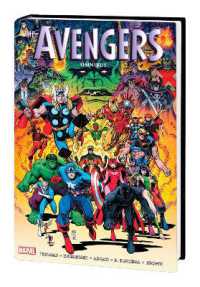- ホーム
- > 洋書
- > 英文書
- > Literary Criticism
Full Description
From the influential work of Los Bros Hernandez in Love & Rockets, to comic strips and political cartoons, to traditional superheroes made nontraditional by means of racial and sexual identity (e.g., Miles Morales/Spider-Man), comics have become a vibrant medium to express Latino identity and culture. Indeed, Latino fiction and nonfiction narratives are rapidly proliferating in graphic media as diverse and varied in form and content as is the whole of Latino culture today.
Graphic Borders presents the most thorough exploration of comics by and about Latinos currently available. Thirteen essays and one interview by eminent and rising scholars of comics bring to life this exciting graphic genre that conveys the distinctive and wide-ranging experiences of Latinos in the United States. The contributors' exhilarating excavations delve into the following areas: comics created by Latinos that push the boundaries of generic conventions; Latino comic book author-artists who complicate issues of race and gender through their careful reconfigurations of the body; comic strips; Latino superheroes in mainstream comics; and the complex ways that Latino superheroes are created and consumed within larger popular cultural trends. Taken as a whole, the book unveils the resplendent riches of comics by and about Latinos and proves that there are no limits to the ways in which Latinos can be represented and imagined in the world of comics.
Contents
Taking Back Control of Our Story Space: A Foreword (Frank Espinosa)
Latino Comic Books Past, Present, and Future-A Primer (Frederick Luis Aldama and Christopher GonzÁlez)
Part I. Alternativas
One. Out of Sequence: Time and Meaning in Los Bros Hernandez (Patrick L. Hamilton)
Two. Recreative Graphic Novel Acts in Gilbert Hernandez's Twenty-First-Century Neo-Noirs (Frederick Luis Aldama)
Three. Three Decades with Gilbert and Jaime Hernandez: An Odyssey by Interview (Christopher GonzÁlez)
Part II. Cuerpo Comics
Four. Biographic Challenges: Wilfred Santiago's 21: The Story of Roberto Clemente (Christopher GonzÁlez)
Five. Wrestling with Comic Genres and Genders: Luchadores as Signifiers in Sonambulo and Locas (Ellen M. Gil-GÓmez)
Part III. Tortilla Strips
Six. Latino Identity and the Market: Making Sense of CantÚ and Castellanos's Baldo (HÉctor FernÁndez L'Hoeste)
Seven. The Archeology of the Post-social in the Comics of Lalo Alcaraz: La Cucaracha and Migra Mouse: Political Cartoons on Immigration (Juan Poblete)
Eight. My Debt to Rius (Ilan Stavans)
Part IV. A Bird, a Plane ... Straight and Queer Super-Lats
Nine. The Alien Is Here to Stay: Otherness, Anti-Assimilation, and Empowerment in Latino/a Superhero Comics (Mauricio Espinoza)
Ten. Anya SofÍa (AraÑa) CorazÓn: The Inner Webbings and Mexi-Ricanization of Spider-Girl (Isabel MillÁn)
Eleven. Revealing Secret Identities: Gay Latino Superheroes and the Necessity of Disclosure (Richard T. RodrÍguez)
Part V. Multiverses, Admixtures, and More
Twelve. Everybody Wants to Rule the Multiverse: Latino Spider-Men in Marvel's Media Empire (Kathryn M. Frank)
Thirteen. Mapping the Blatino Badlands and Borderlands of American Pop Culture (Adilifu Nama and Maya Haddad)
Fourteen. The Paradox of Miles Morales: Social Gatekeeping and the Browning of America's Spider-Man (Brian Montes)
Works Cited
Contributors
Index








